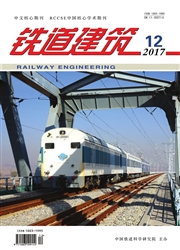

 中文摘要:
中文摘要:
为研究钢轨打磨对轮轨接触关系的影响,根据武广高铁历次打磨后轨检车检测的轨道不平顺质量指数,选取现场实际打磨后的轮轨廓形,建立“车轮-钢轨”接触关系模型并进行有限元仿真计算,计算结果表明打磨后轮轨接触点会向钢轨踏面中心移动.通过对钢轨光带和廓形的跟踪调研发现:打磨后钢轨顶部形成20-30mm的光带;打磨13个月后,通过总重约为3.979×10^7t,钢轨光带有变宽和双点接触的轻微痕迹;打磨17个月后,通过总重为5.203×10^7t,光带明显变宽,宽度约为35mm.通过采集株洲和广州高铁工务段动检车的横向加速度报警量,发现钢轨打磨能有效减少动车横向加速度报警.通过分析长沙供电段供电量的变化,发现钢轨打磨能在一定程度上降低动车的耗电量.
 英文摘要:
英文摘要:
According to the track irregularity quality index by track inspection car of the grinded Wuhan-Guangzhou high-speed rail,the actual wheel-rail profile after grinding was simulated using finite element method in order to study the effect of rail grinding on wheel-rail contact condition.The calculation results show that wheel-rail contact points move to the rail surface center after grinding,a 20-30mm contact band occurs at the top of rail after grinding.Slight widening of contact band and double-point contact arises when the passing gross weight is about 3.979×10^7 t,13 months later after the grinding.Contact band width increases significantly up to 35 mm when the passing gross weight is about 5.203×10^7 t,17 months later after the grinding,The alarm parameters of the lateral acceleration of track inspection car at Zhuzhou and Guanzhou high-speed track division indicate that rail grinding can effectively reduce the lateral acceleration alarms of the trains.To some extent,the change of power supply in Changsha power supply station indicates that rail grinding can effectively reduce the power consumption of the trains.
 同期刊论文项目
同期刊论文项目
 同项目期刊论文
同项目期刊论文
 期刊信息
期刊信息
